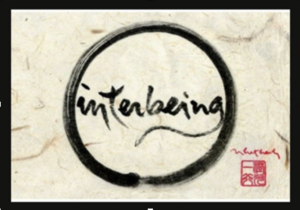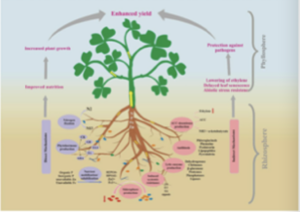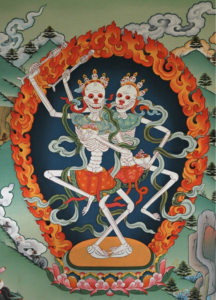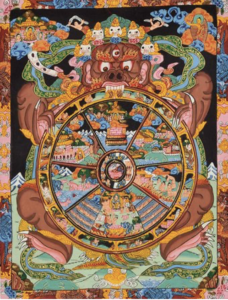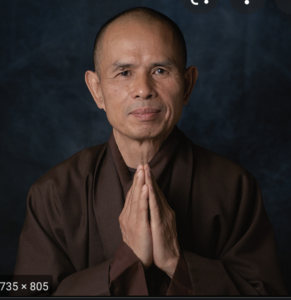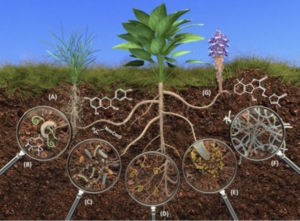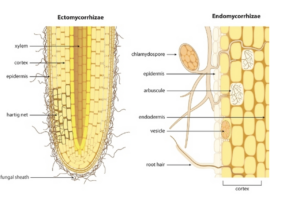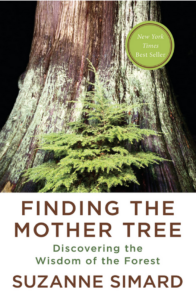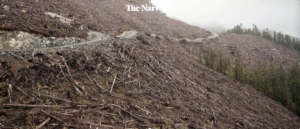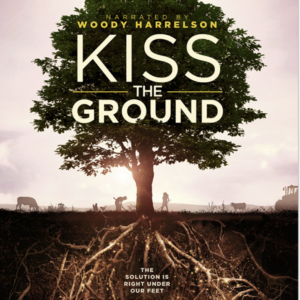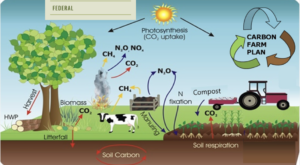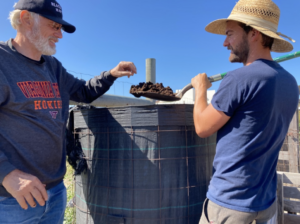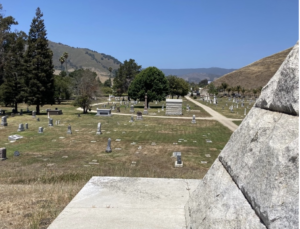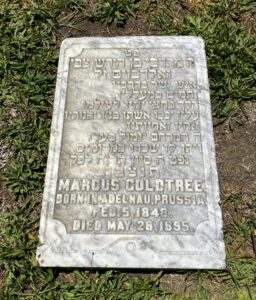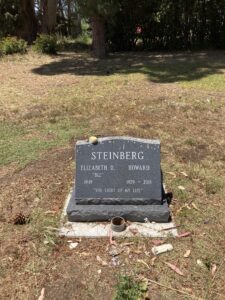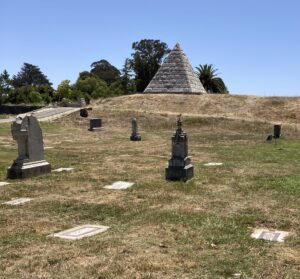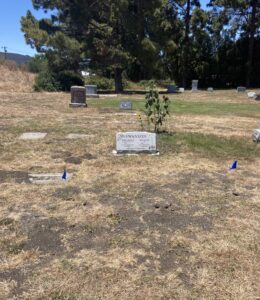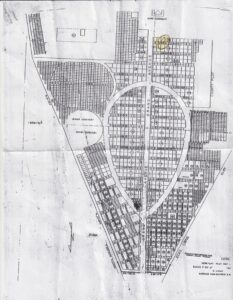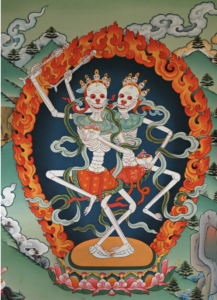Interbeing, the Rhizosphere and Green Burial
1. Interbeing
Thich Nhat Hanh coined the word interbeing as a modern label for the traditional doctrine of Dependent Origination or pratityasamutpada, a doctrine taught in all schools of Buddhism.
The term Dependent Origination has two associated but distinct references in different Buddhist traditions.
For the Theravada it refers to a chain of causation known as the twelve nidanas that accounts for the descent from nirvana and wholeness through various spiritual and mental states into the material world of illusion, procreation, life and death known as samsara.[1]
In the Mahayana tradition dependent origination has a more general reference signifying “the mutual containment and interpenetration of all phenomena,” and “a cosmos of infinite realms upon realms, mutually containing one another.”[2]
In developing his practical philosophy of “engaged buddhism,” Thich Nhat Hahn draws more on this tradition.
Here is how he arrived at the word Interbeing:
About thirty years ago I was looking for an English word to describe our deep interconnection with everything else. I liked the word “togetherness,” but I finally came up with the word “interbeing.” The verb “to be” can be misleading, because we cannot be by ourselves, alone. … To inter-be and the action of interbeing reflects reality more accurately. We inter-are with one another and with all life.[3]
He relates that idea to words attributed directly to The Buddha in Assutava Sutta
When this is, that is.
From the arising of this comes the arising of that.
When this isn’t, that isn’t.
From the cessation of this comes the cessation of that.
The point is that all of existence is a vast nexus of causes and conditions, constantly changing, and everything is interconnected to everything else. All phenomena inter-exist.
This idea is both counter-intuitive and yet obvious, especially in the context of modern science, whose technological instruments allow for access to realities great and small, all of which reveal interconnections at scales far beyond the reach of human senses.
One of the things that makes Thich Nhat Hanh’s teachings attractive to a wide audience is his affirmation of scientific knowledge
Personally, learning about science has helped me to understand Buddhism more deeply. I agree with Einstein that if there is a religion that can go along with science, it is Buddhism. That is because Buddhism has the spirit of nonattachment to rules. You may have a view that you consider to be the truth, but if you cling to it, then that is the end of your free inquiring. You have to be aware that with the practice of looking deeply, you may see things more clearly. That is why you should not be so dogmatic about what you have found; you have to be ready to release your view in order to get a higher insight. That is very exciting.[4] …
There is a biologist named Lewis Thomas, whose work I appreciate very much. He describes how our human bodies are “shared, rented, and occupied” by countless other tiny organisms, without whom we couldn’t “move a muscle, drum a finger, or think a thought.” Our body is a community, and the trillions of non-human cells in our body are even more numerous than the human cells. …There are, he says, no solitary beings. The whole planet is one giant, living, breathing cell, with all its working parts linked in symbiosis.[5]
In addition to the multiple lives that make up each cell, a further example of interbeing or dependent origination is found in the microbiome—the vast collections of cells like bacteria, fungi, and viruses found on and in our human bodies that each have their own dna and carry out essential functions of our lives.
2. Rhizome and rhizosphere
Recent research has called attention to yet another microbiome, not the one which inhabits our bodies but one which exists outside them in the soil that serves as the source of all plant and animal life.
The word rhizosphere derives from the Greek word, “rhiza,” signifying root and describes the plantroot interface with the surrounding below-ground environment of the soil and its dense microbial communities.
The rhizosphere is now seen as a hotspot for interaction and communication among microscopic animals, plants, bacteria, and fungi.
In addition to local exchanges between organisms, it extends into an immense subsurface network drawing all its inhabitants into a unified ecological system.
A salient characteristic of the rhizosphere is Mutualism—a symbiotic exchange of resources that fulfill needs of each of its inhabitants. The microorganisms assist plants in uptake of nutrients like organic nitrogen and amino acids that stimulate plant growth, stress-tolerance and resistance to pathogens. The plants feed the microorganisms with necessary carbon-rich carbohydrates and sugars which they cannot create themselves.
This exchange takes place among plant roots and fungi, known as mycorrhizae, a word derived from “mico” for mushroom, and “rhizome.”
Branching tentacles of the fungi, called “hyphae,” grow on and into root hairs, extending their surface area and capacity to absorb water and essential mineral nutrients
The ancient fossil record suggests that all land plants evolved largely as a result of such mycorrohizal associations with aquatic vegetation.
In addition to nutrient exchange the rhizosphere hosts a dense mycorrhizal communication network that has been categorized as an “information super-highway.” Data is transmitted to nearby receptors through electrical signals and reactions among what are called “infochemicals.” Both plants and fungi alter their behavior based on such signals of attraction or threat.
On the largest scale, the rhizosphere’s carbon cycling interactions among plants, soil and atmosphere regulate whole-ecosystem processes that either promote or reduce climate change.[6]
3. Forestry
The themes of interbeing and the rhizosphere come together in the work of Suzanne Simard, a Canadian forest ecologist whose recent personal and professional autobiography, Finding the Mother Tree: Discovering the Wisdom of the Forest, has attracted widespread attention.
I was first introduced to her as a memorable fictional character named Virginia Westerford, in The Overstory, Richard Powers’ 2018 novel about trees and their protectors. There she appears as reticent researcher who discovers that trees in a forest communicate and cooperate by way of mycorrhizal networks in the rhizosphere.
Simard’s combined account of her discoveries and her personal experiences exceeds the fiction in drama, scientific scope, and philosophical implication. In vivid fluent prose, she describes her upbringing in a Canadian wilderness community where her father and grandfather practiced sustainable selective logging. Her early love for the woods led her to train as a researcher for the British Columbia Forest Service. But she soon learned that, in league with large corporations, the government not only encouraged, but required clear cuts destroying vast areas of rich biodiversity.
These were followed up with practices intended to promote fast profits: planting monocultural stands of seedlings of single species favored by the market, and eliminating all other vegetation construed as competition to the cash crop, through slash burning, mechanical pruning and application of herbicides.
Reading her account recalled my own horror while working in the woods of British Columbia as a tree planter and tree poisoner to earn a living during our family’s residence there in the 1970s.
Simard suspected that this approach was misguided, even in terms of its limited profit motives, so she set up test-plot experiments using chemical and radioactive tracers and DNA analysis. Her published findings showed that the presence of mixed species led to more vigorous regrowth and disease resistance than did their exclusion. Her experiments also revealed that forest ecology involved more cooperation than competition among trees and species, through the exchange of water, nutrients and alarm signals–all facilitated by mycorrhizal interactions in the rhizosphere. Her work challenged dominant scientific assumptions about Darwinian mechanisms of adaptation, natural selection and fitness, and for many years it was dismissed by most of her colleagues. But in 1997, the prestigious international scientific journal, “Nature,” published her article entitled “Net transfer of carbon between ectomycorrhizal tree species in the field,” and that started to bring her recognition and influence.[i]
Her discovery of cooperative exchanges of resources among trees and fungi led to further experiments revealing mechanisms by which large and established trees become hubs in fungal networks and convey larger amounts of carbon and other exudates to more fragile younger trees and seedlings than any benefits they receive in return. Such “Mother Trees” act as “providers, caregivers and elders—for instance by absorbing nitrogen in the remains of spawning salmon in creeks and transmitting it through mycorrhizal networks to other trees deeper in the forest”(289).
Simard’s experiments revealed that forest ecology involved more cooperation than competition among trees and species through the exchange of water, nutrients and alarm signals–all facilitated by mycorrhizal interactions in the rhizosphere. Her work challenged dominant scientific assumptions about Darwinian mechanisms of adaptation, natural selection and fitness, and for many years it was dismissed by most of her colleagues, exemplifying Thich Nhat Hanh’s insight that genuine scientific inquiry requires readiness “to release your view in order to get a higher insight.”
In the final portion of her autobiography, Suznne Simard recounts the later stages of her career, when, as a recognized authority, she “was enjoying the freedom to ask riskier questions”(259).
Her discovery of cooperative exchanges of resources among trees and fungi led to further experiments revealing mechanisms by which large and established trees act as hubs in fungal networks and convey larger amounts of carbon and other exudates to more fragile younger trees and seedlings than any benefits they receive in return.
She named such mature individuals “Mother trees” and claimed that they act as providers, caregivers and elders–for instance, by absorbing nitrogen in the remains of spawning salmon in creeks and transmitting it through mycorrhizal “networks to other trees deeper in the forest”(289). Released from conventional scientific prohibitions of anthropomorphizing or humanizing natural processes, she has moved toward integrating scientific and metaphorical thinking.
Also unafraid to write frankly about her personal life, Simard describes the breakdown of her early marriage to another forest ecologist as her career advanced. She recounts falling in love with Mary, a physical chemist with whom she hikes and camps, combining recreation with research. And she details how her partner teamed with the rest of her family and hometown friends to provide the support she needed during a years-long ordeal with breast cancer.
She also attributes her recovery to the chemotherapy drug, paclitaxel, derived from yew trees growing in Northwest forests and traditionally used by first nations, native-american people for medicinal purposes.
She reports walking in the woods with her two daughters and indigenous elder, Mary Thomas “to learn the ways of the forest and to see if the ecosystem really was a place where all were connected as one”(279). “Mary Thomas’s people,” she says “…had known this…from living in the forest…and learning from all living things, respecting them as equal partners”(282).
She speaks of learning from her: “a way of knowing the earth…knowing that we are tied to the land—the trees and animals and soil and water—and to one another…of showing humility and tolerance, for we all are connected within this circle of life”(294). She urges that “we expand…our epistemology and scientific methodologies so that they complement, build on, and align with Aboriginal roots”(295).
She acknowledges: “I have come full circle to stumble on some indigenous ideals: everything in the universe is connected”(283).
Here she echoes a familiar quotation of John Muir, scientist, visionary and activist, the founder of the Sierra Club: “When we try to pick out anything by itself, we find it hitched to everything else in the Universe.” Simard’s path here brings her into striking proximity with the life and work of Robin Wall Kimmerer, a member of the Powahtony Nation and Professor of Botany, whose book, Braiding Sweetgrass: Indigenous Wisdom, Scientific Knowledge, and the Teachings of Plants also merits being paired with that of Thich Nhat Hahn
4. Carbon Farming/Regenerative Agriculture
Recent scientific research has drawn attention to the importance of another arena of interbeing in the rhizosphere known as “the soil-food web.” This takes place where most agricultural products are grown: the topsoil.
As in forests, plants growing in the topsoil of farmland capture carbon dioxide from the air and, energized by sunlight, combine it with water and chemicals from the soil to create the carbohydrates and sugars, that they need to carry out their life processes.
In addition, the network of fungal hyphae connecting plant roots has a major impact on soil quality by promoting soil aggregate formation and stability—that is structures of attached particles and spaces that increase soil aeration and water infiltration, crucial for plant growth and health as well as for reducing erosion.[7]
In recent years a set of alternative practices, collectively known as Regenerative Agriculture, has been implemented both on large and small farms. An engaging introduction to Regenerative Agriculture can be found in the 2020 feature film, Kiss the Ground:
Traditional farming relies heavily on plowing and tillage to turn over and break up soil before planting to reduce compaction and to control weeds. Regenerative farming, by contrast, requires no-till or low-till cultivation that leaves soil structure intact.
This method is also referred to as “Carbon Farming.” Rather than releasing large amounts of carbon stored in soil into the atmosphere as greenhouse gases, it achieves sequestration of atmospheric carbon in the soil, thereby converting agricultural lands from carbon emitters to carbon sinks.
5. Compost
One of the most important of Regenerative Agricultural practices is heavy and continuing application of compost made from adding decomposing waste products and dead bodies of vegetables and animals to the living soil.
Composting is fundamental for all organic and sustainable agriculture, as it was for all agriculture before the introduction of chemical /industrial agriculture, which replaced it with application of synthetic fertilizers generated out of petroleum products.
Around the time the film was released in 2020, Atascadero resident, Tim Lasalle, a co-founder of the Center for Regenerative Agriculture and Resilient Systems in Chico CA, introduced these regenerative practices to San Luis Obispo residents in a series of local lectures and workshops. At City Farm San Luis Obispo, we have implemented them with encouraging results both above and below ground.
One innovation developed at the Center is production of fungally rich compost from wood chips, leaves and water in a home built “Bioreactor.” A supplement to conventional organic compost and vermicompost, this mixture ripens for a year and then is used to inoculate seedling roots and vegetable beds with enhanced mycorrhizal life.
City Farm manager Shane Lovell has built two of the reactors, for our own use and for distribution of its product to farmers and gardeners.
Thich Nhat Hahn repeatedly spoke of composting as an illustration of interbeing
When we look deeply at a flower, we can see that it is made entirely of non-flower elements, like sunshine, rain, soil, compost, air, and time. If we continue to look deeply, we will also notice that the flower is on her way to becoming compost. If we don’t notice this, we will be shocked when the flower begins to decompose. When we look deeply at the compost, we see that it is also on its way to becoming flowers, and we realize that flowers and compost “inter-are.” [8]
Composting extends the meaning of interbeing from the unity of all life to the unity of life and death.
6. Green Burial
This fundamental insight was brought home by events that occurred last January.
Less than a week after I gave this talk, on January 22, Thich Nhat Hanh died at age 94. Six weeks earlier Jan and I attended the celebration of Life in Morro Bay of Melody Demerit, and on March 20 here at the Center the celebration of life of Nancy Lucas, two people who were close friends with one another and longtime members of the White Heron Sangha. The both were close colleagues of mine for twenty years in the English Department at Cal Poly.
Then at a Land Conservancy reception on April 29, Jan and I ran across an old friend who’s been working for years on promoting what she referred to as Green Burial, that is, interment directly in the earth wrapped only in a fabric shroud. She told us that she and her husband purchased plots in an old cemetery near Creston recently reclaimed for this purpose to fulfill their intention to avoid the expenditure of energy, the atmospheric carbon pollution and the considerable cost involved in cremation.
Both my parents and Jan’s had chosen cremation over the extravagant commercialized alternative of embalming and cemetery interment in a fancy coffin intended to preserve remains intact. Cremation had also been our default choice. But after the conversation with Rosemary and Cal, the prospect of being industrially disposed of in a gas fired oven appeared less appealing than ending up as part of the soil.
That night I searched the internet and found that Green Burial was a growing trend for people of our generation and that indeed it was an available option in the venerable San Luis Obispo Cemetery located at Higuera Street and Elks Lane between Central Coast Brewing and the Sunset Drive-in Theatre.
Next day Jan and I walked through it discovering monuments dating to the 1880’s
A large Jewish section, and graves of people we’d known and admired, both filled, and prepared for future occupancy. Monuments marking the placement of married couples with a single stone recalled the vow we’d uttered somewhat hypothetically 55 years earlier: “till death do us part.”
Discovering this place in the midst of the City we’ve come to feel identified with led to a quick decision. The owner-manager showed us an extensive area reserved for green burial in the newer section of the cemetery and four remaining plots in the older portion, located near some pine and eucalyptus trees and a large elevated granite pyramid. We chose two of those.
Before we purchased the real property deed that would finalize our decision, I went back online to explore some relevant burial traditions. For observant Jews, Green Burial has always been the way to go: in a pine box with holes drilled to hasten decomposition. Native Americans tend to believe that human bodily remains share the sacredness of the earth to which they return and that disturbance of that reunification is sacrilege.
For Buddhists, funerary practices vary widely. Buddha himself was cremated and this is the most frequent custom. But in the Sattipatana Sutta, the Buddha is said to have recommended extended stays in cemeteries where “bodies were not buried or burned but just discarded… out of compassion for the animal kingdom, for vultures and other animals to eat. So yogis would observe the human body in various states of decomposition and work with what that brought up in themselves.”[9] Such “Death awareness practise,” known as marana sati meditation, is expected to induce wisdom and a tranquil state of mind.
Depicted in this Tanka or Tibetan Buddhist Icon is Citipati, known as the protector of graveyards or the Lord of the Cemetery. “It is formed of two skeletal deities, one male and the other female, both dancing wildly with their limbs intertwined inside a halo of flames representing change.[1] Their symbol is meant to represent both the eternal dance of death as well as perfect awareness.”[10]
Many Buddhist customs presume that though the body is subject to anicca or nature’s continual transformations, the soul or spirit remains intact and persists after death to become reincarnated in another body or finally to be released into nirvana.
I don’t know about that, but what I have learned from an article about “the science behind green burial” provides assurance that it optimally allows for composting whatever else persists.
Decomposition of the body begins shortly after death, when cells die and begin the process of breaking down. It takes close to 72 hours for micro-organisms to begin putrefaction within the body.
…proteins begin releasing gasses such as purscine, cadaverine, hydrogen sulfide, methane, ammonia, nitrate, sulfide … and organic acids. Carbohydrates decompose to sugars, a process aided by bacteria and fungi. … Micro-organisms naturally present in the intestine, such as fecal coliform, E. coli, … break down the dead intestinal cells, and bacteria such as coliforms and clostridia begin traveling to other body parts. Organs that house digestive enzymes such as the pancreas and liver, for instance, release those enzymes and begin to self-digest…the body is buried at the optimum depth in soil capable of binding organic material while promoting rapid, uninhibited, aerobic decomposition, resulting in the decay that creates the basis for fertile soil.”
For me, that promises the completion of interbeing in the rhizosphere.
_______
[1] O’Brien, Barbara. “Interbeing.” Learn Religions, Aug. 26, 2020, learnreligions.com/interbeing-3866931.
[2] O’Brien, Barbara. “Interbeing.” Learn Religions, Aug. 26, 2020, learnreligions.com/interbeing-3866931.
[3] https://www.garrisoninstitute.org/blog/insight-of-interbeing/
[4] In Melvin McLeod (ed.), ‘Love without Limit: An Interview with Thich Nhat Hanh’, The Best Buddhist Writing 2007 (2007), 74.
[5] Thich, Nhat Hanh. 1999. New York: Broadway Books.
[6] https://www.nature.com/scitable/knowledge/library/the-rhizosphere-roots-soil-and-67500617/
[7] https://www.researchgate.net/publication/7011574_Mycorrhizas_and_soil_structure
[8] Thich Nhat Hanh, Stepping Into Freedom
[9] https://tricycle.org/magazine/buddhist-death-rites/

